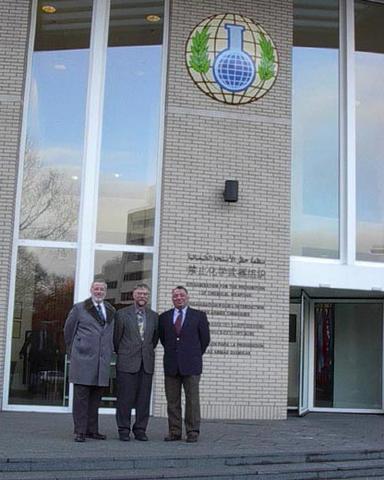NIST Scientists Contribute to Nobel Peace Prize Winning Efforts on Chemical Weapons Detection

NIST scientists Ed White, Gary Mallard and Edgar Etz (L-to-R) at OPCW headquarters in The Hague.
Innovative chemical weapons detection technologies developed by scientists at the National Institute of Standards and Technology (NIST) have played a key role in the Organization for the Prohibition of Chemical Weapons' (OPCW) efforts to eliminate chemical weapons. For their work overseeing the Chemical Weapons Convention (CWC), including the recent UN inspections in Syria, OPCW was recently recognized with the 2013 Nobel Peace Prize. The CWC is a treaty entered into by 190 nations to eliminate chemical weapons, and is overseen by OPCW, located in The Hague, The Netherlands.
NIST involvement with the OPCW began with the Preparatory Commission, established in 1993, to make the necessary preparations for the effective implementation of the CWC. A critical issue for the acceptance of the treaty was ensuring that on site chemical analyses (whether commercial or military) not reveal confidential information beyond the scope of the treaty. At the time, the only method of finding out if a chemical agent was present in the sample was to examine a gas-chromatograph/mass spectral analysis (GC/MS) data file in great detail – a process through which other chemicals in the mixture, not relevant to the treaty, could also be discovered.
For the United States and many other countries, this possible loss of confidential business information in the inspection of commercial facilities was a critical issue. Beginning in 1995, with support from the Defense Threat Reduction Agency (DRTA), NIST Fellow Steve Stein developed a tool (now called AMDIS – Automatic Mass spectral Deconvolution and Identification System) to compare each component in the generated data file to a library of chemical agents and chemical agent precursors, and report only those components that matched the library. In addition, AMDIS could use information on the amount of time taken by the agent to elute from the chromatogram (the retention index) to help differentiate between chemical agents as well as reduce the risk of false positive identifications. The ability of AMDIS to find very low concentrations of chemical agents in complex mixtures is today widely recognized by all of the laboratories that assist the OPCW and it remains an important part of the tool kit for all of the laboratories that analyze for chemical agents. In fact, AMDIS has gained wide acceptance in diverse fields such as metabolomics and environmental analysis.
After the CWC was accepted and went into force on in 1997, AMDIS was formally accepted for use in the inspection process. However, additional data were still needed. The initial spectral libraries had limited scope and many potential chemical agents were not covered in the libraries. The OPCW thus established a Validation Group for the OPCW Central Analytical Database (OCAD) to provide the information used by AMDIS during inspections. The Validation Group was responsible for the quality of the spectral data placed in the database as well as the accuracy of the retention information. From the beginning, NIST analytical chemists Ed White and Gary Mallard worked with the Validation Group (on mass spectra and retention index data respectively), while fellow NIST scientists Edgar Etz, and later Steve Choquette were also active on the sub-group evaluating infra-red spectra of chemical agents. Mallard served as chairman of the Validation Group prior to retiring from NIST, and also acted as an adviser to the U.S. Delegation to the OPCW on negotiations on sample handling and transfer. Upon leaving NIST in 2006 Gary Mallard led the OPCW laboratory for three and a half years. Now a contractor to NIST, Mallard remains active with the Validation Group, and trains OPCW inspectors.
NIST contributions to the OPCW were vital to satisfying U.S. requirements for signing the treaty and are now directly incorporated into the OPCW inspection regime. Detection methods developed by researchers at NIST are used for all inspections to both ensure confidentiality and to detect chemical agents in complex matrices at exceedingly low concentrations. In addition, each inspection mission that does chemical analysis carries with it a copy of the NIST Mass Spectral Library and the NIST Mass Spectral Search Engine for use in case it is needed during an inspection. The OPCW relies on a network of laboratories in various countries around the world to analyze for chemical weapons – it is these laboratories that were used in the recent UN inspections in Syria – and in all of these laboratories, AMDIS is a mainstay of the analysis.

